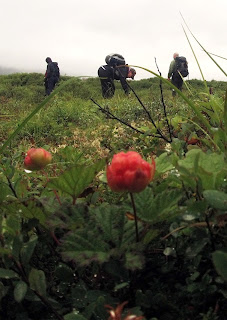Only in Nome, AK, does it make sense to drive 2 and a 1/2 hours north at 6 o'clock at night after work on a week night to visit a hot spring that you were told not to go to.
Well, on that flawless logic, that's exactly what I did with a group of coworkers and friends.
Pilgrim Hot Springs is a well known, but off-the-beaten-path destination in the mountains north of town. It's hard to get to, the road is unmaintained and flooded, and we were told it was closed until further notice. So we went anyway.
 |
| Flooded road |
The weather was perfect -- a warm 60-something degrees and sunny. We made it all the way, crawling slowly through a couple feet of water at times, still expecting to find the road closed or some construction worker to make us turn back.
 |
| Tattoo (far right) deep in an enthusiastic conversation |
Instead, when we came to the end of the road we were greeted by a man who went by the name of "Tattoo." When I first saw him talking to my friend in the car ahead of us, he was waving his arms frantically and talking loudly -- I thought he was telling us to turn back.
As it turned out though, he was enthusiastically welcoming us and was quite the talker. Tattoo explained that he'd lived in Alaska for decades; he originally came here as a miner in the 80s or something, but didn't find it lucrative enough so he became a construction worker, living out in the middle of nowhere as he does now. Indeed, it seemed he had been out in the middle of nowhere for many years, based on his over-excitement at seeing visitors. He was a total character, exclaiming "Right on, man!" and "Rad, dude!" to everything and talking about how much he loved weed and cocktails.
Tattoo finally let us continue on our way past the gate, telling us "Have fun and don't get carried off by mosquitoes!"
 |
| Wagon wheel |
Beyond the overgrown gate, we followed a narrow path through grasses and wildflowers that grew higher than my head. Pilgrim Hot Springs was originally an orphanage for the now-nonexistent village of Mary's Igloo at the turn of the century in the early 1900s. The buildings and hot tub still remain.
Our first stop was the hot tub, a raised platform with a big scummy cauldron in the middle, but it turned out to be too hot to even touch. Although it had a breathtaking view of the mountains, we decided to move on and check out the abandoned buildings.
 |
| View from top window of the orphanage |
Among the buildings at the site includes the old Catholic church, and the orphanage building. There are actual trees growing there too, following the path of the hot spring creek, which steams and meanders through the area, making it feel totally out of place for the Seward Peninsula.
We climbed into the Catholic church through a busted out window. Inside it was dusty, eerie, and mostly empty save for an old wood stove and some broken early 1900s furniture, but for the most part it seemed everything had been salvaged. Upstairs we found the sanctuary, the confessional, old paintings, and the pulpit.
Afterwards, we entered the old orphanage through a creaky wooden door with a leather horse harness still hanging on the inside. It looked as if the bottom floor was being used for storage, but upstairs were two large rooms that bowed inwards, making it feel like a creepy fun house. There were still old bunkbeds and cribs, and remnants of curtains hanging in the windows. Amazing to think this had been crowded with children and nuns over a hundred years ago, and today it's left battered and abandoned, but still somewhat preserved.
 |
| The Mud Hole |
It was getting late, so we eventually had to peel ourselves away from the intrigue of the old buildings and check out the natural pool of the hot spring (dubbed "the mud hole") that was reportedly a more tolerable temperature than the tub.
Indeed it was, although the temperature still felt scalding. Strangely, the gritty mud at the bottom of the pool was hotter than the water, and felt as if it was searing your feet when you waded in. There was a weird piece of plastic on the middle to stand on though, which I managed to enjoy for a few minutes before it got too hot.
 |
| Another hot springs pool |
After spending a short amount of time frolicking around in the hot pools, we knew we had to get back before it got any later. Seemingly for the first time this summer, the sun was beginning to set, casting brilliant colors across the mountains and meadows.
On the ride home, it sent out spectacular rays through the clouds, giving us a breathtaking view to make up for the cold, bumpy ride in the back of the pickup truck.
 |
| Mountain sunset |
We didn't get back until well after midnight, had to go to work the next day, but it was more than worth it. I might even dare to say that in some ways I liked Pilgrim Hot Springs better than Serpentine, but they really can't be compared.
Pilgrim was incredible for its history, its beauty as a warm, forested oasis on the tundra, and the interesting characters encountered along the way. I'm not sure if I'll ever get back there, but I'm glad I got to see it.


















.JPG)
.JPG)





















